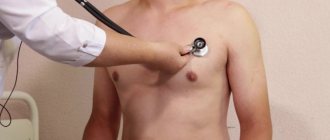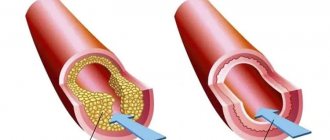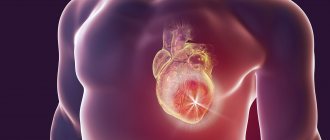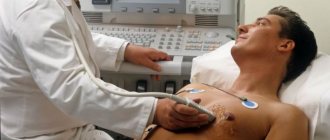List of heart diseases
This table presents the changes and a list of violations that relate to them.
| Changes | Diseases |
| Inflammatory |
|
| Ischemic |
|
| Heart rhythm disturbances | Arrhythmias:
Fibrillation (atrial fibrillation) and atrial flutter. Ventricular fibrillation and flutter. Heart blocks:
|
| Cardiomyopathies |
|
| Disorders of the anatomical structure of the heart | Congenital heart defects:
Acquired heart defects:
Heart cancer. |
| Heart failure |
|
| Arterial hypertension (high blood pressure) |
|
| Aortic diseases |
|
The heart did not hurt, but died suddenly: how to recognize ischemia in time?
Cardiovascular diseases have always been considered the main cause of mortality for humanity. It is surprising that many people still underestimate heart disease. Like, having cancer is the scourge of the 21st century. There is AIDS - the plague of the 21st century. There are road traffic injuries... This is what we need to fight. And my heart will ache and stop.
Although, if you look at the mortality statistics in Russia from various causes, 22% die annually from cancer, 3% from injuries (including road accidents), and less than 1% from AIDS. And the mortality rate from cardiovascular diseases in our country is 56%. That is, more than half of Russians die from heart disease! Almost 10 million people in our country, according to doctors, suffer from cardiovascular diseases.
We talked to specialists from the Voronezh Regional Clinical Center for Public Health and Medical Prevention about what are the main risk factors for cardiovascular diseases and what needs to be done to avoid heart disease.
What are the most dangerous cardiovascular diseases?
All cardiovascular diseases are divided into diseases of the heart, arteries and veins. The main danger is heart disease, and primarily coronary heart disease (CHD), since it is the main cause of mortality.
Coronary heart disease is a disease in which a person’s blood supply to the myocardium (heart muscle tissue) is disrupted due to pathologies of the coronary arteries
Many are accustomed to thinking that the manifestation of coronary artery disease is angina pectoris (a clinical syndrome characterized by a feeling of pain or discomfort in the chest). Most people think like this: if my heart hurts, then I’ll go to the doctor.
Indeed, in 50% of patients with coronary artery disease, angina pectoris is the first manifestation of the disease. But only 40–50% of patients with angina pectoris know about their disease. In the remaining 50–60% it remains unrecognized. People can live peacefully and not even suspect about the insidious disease. It may take many years before CAD causes sudden and catastrophic consequences.
It is important to understand that the first manifestation of coronary heart disease may be myocardial infarction or sudden death (according to the Framingham study of 5144 people - in men in 62%, in women in 46% of cases). The life of a man aged 60 is shortened by 9 years if he suffers a myocardial infarction, and by 12 if he suffers a stroke.
What are the risk factors for coronary heart disease?
Coronary heart disease is the end result of the interaction of a number of risk factors, which are divided into two groups - modifiable and non-modifiable risks.
Modifiable risks include those that a person can influence in some way - try to avoid them in his life, reduce or completely neutralize their impact. These are the majority of risks.
Unchangeable risks include risks that represent a certain reality, that is, conditions and circumstances that cannot be eliminated or influenced in any way. Fortunately, such risks are in the minority.
Below are the most significant risk factors that directly or indirectly affect the occurrence and development of IHD:
Lifestyle (modifiable risks):
- poor nutrition;
- smoking;
- excessive alcohol consumption;
- low physical activity;
- low social and educational status.
Biochemical or physiological factors (modifiable risks):
- high blood pressure;
- elevated cholesterol levels;
- elevated triglyceride levels;
- hyperglycemia/diabetes mellitus;
- obesity;
- thrombogenic factors;
- environmental pollution.
Individual characteristics (unchangeable risks):
- age (the older a person is, the higher the risk of developing IHD);
- gender (as statistics show, mortality from cardiovascular diseases in men under 65 years of age is 3 times higher than in women);
- heredity (early development of IHD in relatives).
What should you do to avoid IHD?
1. Analyze your lifestyle and, if there are these risks in it, try to get rid of them.
There are extremely effective things you can do right now. For example, quit smoking (if you smoke). Remember: quitting smoking reduces the risk of developing myocardial infarction by 36%! The risk of developing coronary heart disease (CHD) in a person who quits smoking within one year is reduced by 2 times compared to the same risk in a smoker, and after 15 years it is completely reduced to the level of the risk of a non-smoker.
2. Undergo a medical examination, which may identify risks associated with the physiological characteristics of the body.
Timely examination allows you to prevent the development of the disease, identify groups of people who need active preventive measures, increase the duration and improve the quality of life. In countries where primary prevention efforts have been active since 1970, cardiovascular morbidity has decreased significantly over the past 20 years. Thus, in the USA, Canada and the European Union, mortality from ischemic heart disease is more than 2 times lower, and from stroke – 5 times lower than in Russia.
The material was prepared within the framework of the national project “Demography”
Causes of heart disease and symptoms associated with their occurrence
The symptoms and causes of these heart diseases are the most common in the general population. But it is worth saying that the origin of some violations cannot be determined. This is especially true for those that occur with inflammation of the heart muscle and valve apparatus. Regarding symptoms: they may not be present at the onset of the disease, or the patient will not always pay attention to the deterioration in well-being. This leads to progression of the disease, difficulties in its treatment, decreased quality of life and increased risk of mortality.
| Changes | Causes | Signs of Heart Disease |
| Inflammatory |
|
|
| Ischemic (coronary heart disease) |
|
|
| Heart rhythm disturbances |
|
|
| Cardiomyopathies |
|
|
| Disorders of the anatomical structure of the heart |
|
|
| Heart failure |
|
|
| Arterial hypertension |
|
More often, symptoms occur during a hypertensive crisis. |
A common disease is cardiac arrhythmia in a child.
Heart rhythm disturbances in children account for a quarter of all diseases in children under 3 years of age. Also, manifestations become more active at the age of 11–13 years, when the child is actively growing. It is extremely important to constantly visit a pediatric cardiologist in Saratov, who will listen to the rhythm during the appointment and, if necessary, prescribe an ECG or ultrasound of the heart. If heart rhythm disturbances in a child are not treated in time, it will develop into arrhythmia, which is becoming more and more difficult to overcome every year.
In second place in the number of patients with childhood heart disease are congenital disorders.
Some childhood heart diseases, such as mitral valve prolapse or myocarditis, may appear 2-4 weeks after viral infections such as:
- measles;
- diphtheria;
- herpes;
- flu;
- angina
- ARVI and acute respiratory infections with complications.
After the active stage of the disease and during the recovery period, it is necessary to visit a pediatric cardiologist in Saratov, who will prescribe the necessary tests and examinations, as well as formulate comprehensive heart prevention to minimize the risk of developing disorders. Children's heart disease in the form of extraneous noise against the background of neoplasms can be triggered by rheumatism, which manifests itself after a sore throat.
What heart diseases are considered fatal and very serious?
Among all heart disorders, there are those that threaten human health and life more than others. How the disease develops and the prognosis for each individual patient depends on many factors:
age;- floor;
- the severity and stage of the disease itself;
- presence of concomitant diseases;
- quality and timeliness of treatment and medications;
- the patient's lifestyle.
But still, the most dangerous and fatal diseases include:
- IHD. Its progression leads to myocardial infarction, some forms of which are fatal, as they lead to life-threatening arrhythmias, rupture and cardiac arrest.
- Congenital heart defects: with some anatomical changes, the organ is not able to cope with its function.
- Cardiomyopathies are more likely than other diseases to lead to heart failure, which, in turn, leads to death.
- Heart cancer.
- Ventricular tachycardia and fibrillation lead to cardiac arrest.
- Complete atrioventricular block (causes bradycardia and cardiac arrest).
- Aortic dissection and aneurysm.
- Pulmonary embolism (PE).
It is important to remember that pericarditis, myocarditis, acquired heart defects, etc. can also cause death if left untreated.
No need to be afraid of surgery
If, based on the results of diagnostic studies, surgery is prescribed, this is not a reason to worry about your heart once again. Indeed, a minimally invasive approach is currently being actively developed, which allows the patient to return to normal life activities in one hospitalization with minimal trauma.
In our clinic, coronary artery stenting is performed under X-ray control - endovascular surgery that eliminates incisions.
- At the Meditsina JSC clinic, operations are carried out in compliance with international JCI standards.
- Video recording of operations is carried out.
- A system of SMS notifications to relatives about the start and end of the operation has been introduced.
Minimally invasive surgical operations can reduce the period of rehabilitation and recovery.
For a speedy return to a normal lifestyle, qualified specialists in the rehabilitation department of the clinic use the entire range of physiotherapeutic procedures, enhanced external counterpulsation (which has shown a good effect in the rehabilitation of patients after myocardial infarction and heart failure) and other indispensable methods. And in a specialized cardiac rehabilitation center, cardiac rehabilitation doctors work in close collaboration with cardiologists.
After treatment, we equip patients with complete and up-to-date knowledge about the prevention of cardiovascular diseases, we issue brochures that describe basic diets, observation methods, main risk factors, features of taking medications, rehabilitation methods after a myocardial infarction, and for heart rhythm disturbances.
What symptoms indicate severe heart pathologies?
Signs that are observed in complex heart diseases:
- Loss of consciousness.
Dyspnea.- Severe chest pain.
- Blueness of hands, feet, lips, face.
- Palpitations.
- High or low pressure.
It is very important to know the above symptoms in order to recognize and take the right actions at the pre-medical stage to avoid a bad outcome.
Inflammatory heart diseases
Heart inflammation has different etiologies:
- Infectious inflammation . Caused by microbes, viruses, fungi.
- Autoimmune inflammation . Associated with immune disorders.
- Traumatic inflammation . Develops in the postoperative period.
There are a number of inflammatory heart diseases (such as endocarditis, myocarditis or pericarditis) that can lead to serious complications without medical intervention.
conclusions
Heart disease today is a fairly pressing problem throughout the world. The only method aimed at preventing mortality and disability is prevention.
It should be aimed at:
- stress reduction;
- normalization of sleep and nutrition;
- increased physical activity;
- rejection of bad habits;
- An important aspect is working with a psychologist (since the psychological factor has an impact on the occurrence of many diseases).
Correction of such factors can improve early detection of the disease based on a careful analysis of the data obtained during diagnosis. As a result, a set of therapeutic measures is formed, according to clinical protocols, which will slow down the progression of the pathology. If necessary, therapy is carried out in a cardiology hospital.







